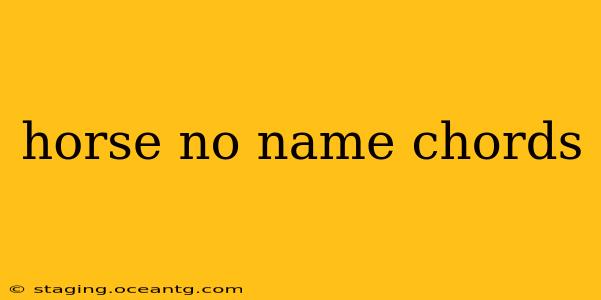Horse With No Name Chords: A Deep Dive into America's Favorite Ballad
America's favorite road song, "Horse With No Name," by America, isn't just a catchy tune; it's a tapestry woven with evocative imagery and a surprisingly simple yet effective chord progression. This guide will delve into the chords, explore variations, and discuss the song's enduring appeal.
The Basic Chords:
The beauty of "Horse With No Name" lies in its simplicity. The song primarily utilizes just four chords: Am (A minor), G (G major), C (C major), and F (F major). This straightforward progression allows the melody and lyrics to shine, creating a feeling of both vastness and intimacy. Most versions stick to these core chords, making it exceptionally accessible for beginners.
The Chord Progression:
The most common progression follows this pattern:
- Verse 1: Am - G - C - F
- Chorus: Am - G - C - F
- Verse 2: Am - G - C - F
- Chorus: Am - G - C - F
- Bridge: (Slight variation often introduced here, sometimes including a Dm or E7)
- Outro: Am - G - C - F
Variations and Interpretations:
While the basic progression is consistent, many artists and guitarists introduce subtle variations to personalize their renditions. These variations often include:
- Inversions: Changing the order of notes within a chord can add depth and complexity.
- Passing Chords: Adding chords between the main four can create smoother transitions. A common addition is a D major chord, providing a slight lift in the progression.
- Seventh Chords: Including seventh chords (like G7 or Fmaj7) can add a richer, jazzier feel to the song.
Understanding the Feel:
The song's melancholic yet hopeful tone is strongly tied to the chord progression. The minor chords (Am) establish the pensive mood, while the major chords (G, C, F) provide moments of uplift and release. This contrast creates the emotional depth that makes the song so memorable.
Frequently Asked Questions (Based on Common Online Searches):
1. What key is Horse With No Name in?
The song is primarily in A minor. While the inclusion of major chords might lead to confusion, the overall tonal center remains firmly within the A minor key.
2. Are there any capo variations for Horse With No Name?
Yes, using a capo allows players to adapt the song to different vocal ranges. Placing a capo on the second fret, for example, effectively transposes the song up two semitones, making it easier to sing for those with higher voices.
3. What are some alternative strumming patterns for Horse With No Name?
Beyond the basic downstrokes, many rhythmic patterns can be applied. Experiment with arpeggios (playing the notes of a chord individually), fingerpicking, or syncopated rhythms to create a personalized feel. The key is to maintain the song's underlying rhythm and feel.
4. Can beginners easily learn Horse With No Name chords?
Absolutely! The simple four-chord progression makes it an ideal song for beginners to learn. Its straightforward nature allows new players to focus on mastering the basic chords and strumming patterns.
5. What makes the chords in Horse With No Name so effective?
The effectiveness of the chords stems from their simplicity and emotional contrast. The straightforward progression allows the lyrics and melody to resonate deeply, while the interplay between major and minor chords creates a compelling emotional arc. The song's enduring popularity is a testament to the power of simplicity and emotional resonance.
This comprehensive guide offers a deeper understanding of the chords in "Horse With No Name," enabling both beginners and experienced players to appreciate and perform this timeless classic. Remember, the best way to learn is to pick up your instrument and start playing!
